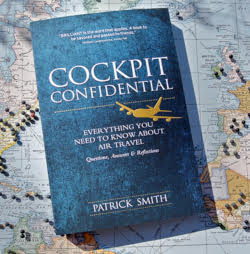We are told that planes basically fly themselves. How true is this?
You’ve heard it a million times: modern aircraft are flown by computer, and in some not-too-distant future, pilots will be engineered out of the picture altogether. The biggest problem with this line of thought is that it begins with a false premise: the idea that jetliners are superautomated machines, with pilots on hand merely to play a backup role in case of trouble. Indeed, the notion of the automatic airplane that “essentially flies itself” is perhaps the most aggravating and stubborn myth in all of aviation.
For example, in a 2012 Wired magazine story on robotics, a reporter had this to say: “A computerized brain known as the autopilot can fly a 787 jet unaided, but irrationally we place human pilots in the cockpit to babysit the autopilot, just in case.”
That’s about the most reckless and grotesque characterization of an airline pilot’s job I’ve ever heard. To say that a 787, or any other airliner, can fly “unaided” and that pilots are on hand to “babysit the autopilot” isn’t just hyperbole or a poetic stretch of the facts. It isn’t just a little bit false. And that a highly respected technology magazine wouldn’t know better, and would allow such a statement to be published, shows you just how pervasive this mythology is. Similarly, in an article in the New York Times not long ago, you would have read how Boeing pilots spend “just seven minutes” piloting their planes during a typical flight. Airbus pilots, the story continued, spend even less time at the controls.
Confident assertions like these appear in the media all the time, to the point where they’re taken for granted. Reporters, most of whom have limited background knowledge of the topic, have a bad habit of taking at face value the claims of researchers and academics who, valuable as their work may be, often have little sense of the day-to-day operational realities of commercial flying. Cue yet another aeronautics professor or university scientist who will blithely assert that yes, without a doubt, a pilotless future is just around the corner. Consequently, travelers have come to have a vastly exaggerated sense of the capabilities of present-day cockpit technology, and they greatly misunderstand how pilots interface with that technology.
The best analogy, I think, is one that compares flying to medicine. Essentially, high-tech cockpit equipment assists pilots in the way that high-tech medical equipment assists physicians and surgeons. It has vastly improved their capabilities, and certain tasks have been simplified, but a plane can no more “fly itself” than a modern operating room can perform an organ transplant “by itself.”
“Talk about medical progress, and people think about technology,” wrote the surgeon and author Atul Gawande in a 2011 issue of The New Yorker. “But the capabilities of doctors matter every bit as much as the technology. This is true of all professions. What ultimately makes the difference is how well people use the technology.”
That about nails it.
And what do terms like “automatic” and “autopilot” mean anyway? Contrary to what people are led to believe, flying remains very hands-on operation, with tremendous amounts of input from the crew. Our hands might not be steering the airplane directly, as would have been the case in the 1930s, but almost everything the airplane does is commanded, one way or the other, by the pilots. The automation only does what we tell it to do. It needs to be instructed when, where, and how to perform its tasks. On the Boeing I fly, I can set up an automatic climb or descent in any of about seven different ways, depending on what’s needed.
What that Times article was trying to say is that pilots spend only so many minutes with their hands physically on the control column or stick. That doesn’t mean they aren’t controlling the aircraft. Pilots “fly” as much or more as they ever have — just in a slightly different way. The emphasis nowadays is on a different skill set, absolutely, but it’s wrong to say this skill set is somehow less important, or less demanding, than the old one.
People would be surprised at how busy a cockpit can become, on even the most routine flight, and with all of the automation running. Tasks ebb and flow, and granted there are stretches of low workload during which, to the nonpilot observer, it would seem that very little requires the crew’s attention. But there also are periods of very high workload, to the point where both pilots can become task-saturated.
One evening I was sitting in economy class when our jet came in for an unusually smooth landing. “Nice job, autopilot!” yelled a guy behind me. Amusing, maybe, but wrong. It was a fully manual touchdown, as the vast majority of touchdowns are. Yes, it’s true that jetliners are certified for automatic landings — called “autolands” in pilot-speak. But in practice they are rare. Fewer than one percent of landings are performed automatically, and the fine print of setting up and managing one of these landings is something I could spend pages trying to explain. If it were as easy as pressing a button, I wouldn’t need to practice them every year in the simulator or review those highlighted tabs in my manuals. In a lot of respects, automatic landings are more work-intensive than those performed by hand.
And if you’re wondering: a full 100 percent of takeoffs are manual. There is no such thing as an automatic takeoff anywhere in commercial aviation.
That fantasy insists on outpacing reality is perhaps symptomatic of our infatuation with technology, and the belief that we can compute our way out of every dilemma or complication. The proliferations of drones, both large and small, military and civilian, also makes it easy to imagine a world of remotely controlled planes. Already pilotless aircraft have been tested, that’s true, and Boeing has acquired a patent on a sophisticated, remotely operated autopilot system. But for now these things exist only in the experimental stages; they’re a long way from widespread use. A handful of successful test flights does not prove the viability of a concept that would carry up to four million passengers every day of the week.
And remember that drones have wholly different missions than commercial aircraft, with a lot less at stake if something goes wrong. You don’t simply take a drone, scale it up, add some seats, and off you go. I’ll note too that by civil aviation standards, the biggest and most sophisticated drones have a terrible safety record. Pilotless planes would need to be at least as safe and reliable as existing ones. It took us many decades to make commercial aviation as safe as it today; we’d be starting over with a largely unproven concept.
I’d like to see a remotely operated plane perform a high-speed takeoff abort after an engine failure, followed by a brake fire and the evacuation of 250 passengers. I would like to see one troubleshoot a pneumatic problem requiring a diversion over mountainous terrain. I’d like to see it thread through a storm front over the middle of the ocean. The idea of trying to handle any one of these, from a room thousands of miles away, is about the scariest thing I can imagine. Hell, even the simple things. Flying is very organic — complex, fluid, always changing — and decision-making is constant and critical. On any given flight, there are innumerable contingencies, large and small, requiring the attention and visceral appraisal of the crew.
And aside from the tremendous safety and technological challenges, we’d also need a more or less full redesign of our aviation infrastructure, from developing a fleet of highly expensive, currently nonexistent aircraft, to a totally new air traffic control system. Each of these would cost tens of billions of dollars and take many years to develop. We still haven’t perfected the idea of unmanned cars, trains, or ships; the leap to commercial aircraft would be harder and more expensive by orders of magnitude. And after all of that, you’d still need human beings to operate these planes from afar.
I’m not saying it’s beyond our capabilities. We could be flying around in unmanned airliners, just as we could be living in cities on Mars, or at the bottom of the ocean. Ultimately, it isn’t a technological challenge so much as one of cost and practicality.
I know how this sounds to some of you. Here’s this Luddite pilot who can’t bear the prospect of seeing his profession go the way of the teletype operator. It’s precisely because I’m an airline pilot that my argument isn’t to be trusted.
You can believe that if you want to, but I assure you I’m being neither naïve nor dishonest. And by no means am I opposed to the advance of technology. What I am opposed to are foolish and fanciful extrapolations of technology, and distorted depictions of what my colleagues and I actually do for a living.



